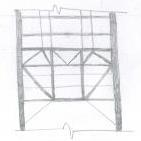
ANStructs
Member-
Posts
30 -
Joined
-
Last visited
-
Days Won
6
ANStructs last won the day on July 26 2022
ANStructs had the most liked content!
Profile Information
-
Gender
Female
-
Location
Karachi
-
University
NED University of Engineering and Technology
-
Employer
A.A.A
-
Interests
Reading, Painting, Watching TV..
Recent Profile Visitors
ANStructs's Achievements
-
Sameel Ahmad started following ANStructs
-
Etabs and SAP2000- Moment distribution in slabs
ANStructs replied to MSKhan's topic in General Discussion
“Most of the resources (books, online forums, videos) I came across on two way slab indicate that moment "will" be higher in the shorter direction than in the longer direction..” In most books, coefficients method for slab design is derived on the assumption that a slab panel is resting on rigid supports i.e. non-deformable supports. Therefore, stiffness of supporting members do not affect the distribution of load from slabs to supporting members. Hence, shorter side of slab which is the more stiffer path carries more load than the longer side. Whereas in a 3D structural model comprising of beam, column and slab, load is distributed based on relative stiffness of elements connecting at a joint. Stiffer element attracts more load and as in your case, the longer slab span proved to be more stiffer load path than the shorter slab span for load to flow. “I want to keep the beam cross section in the long direction as it is, say due to architectural constraints? Is it a hard and fast rule to "make sure" we have more moment in the short direction? Should I always adjust my beam-to-slab stiffness ratio to make sure that happens?” No, you’re not restricted to make sure every shorter direction is the stiffer load path. Assuming the computer model is error free; I would suggest you to properly perform the service and strength design based on the forces you’re getting. “Does it have economic implications?” Not that I know of. -
 Zerihun reacted to a post in a topic:
Etabs and SAP2000- Moment distribution in slabs
Zerihun reacted to a post in a topic:
Etabs and SAP2000- Moment distribution in slabs
-
 UmarMakhzumi reacted to a post in a topic:
Modeling of raft/mat for elevator shaft in multi storied building
UmarMakhzumi reacted to a post in a topic:
Modeling of raft/mat for elevator shaft in multi storied building
-
Etabs and SAP2000- Moment distribution in slabs
ANStructs replied to MSKhan's topic in General Discussion
First thing that come to mind is, beams in longer directions are not stiff enough to restrain the deformation of slab. Try increasing the stiffness of long beam and you might start getting the "one way load distribution" as assumed. -
 UmarMakhzumi reacted to a post in a topic:
BLOCK WALL AT FIXTURES
UmarMakhzumi reacted to a post in a topic:
BLOCK WALL AT FIXTURES
-
Hollow concrete blocks if made following standard procedure are usually very durable and have substantial strength. As far as i know, these blocks have low water absorption than conventional bricks. I think if they are properly placed with high quality mortar, you shouldn't have a problem. You should take my advice with agrain of salt since this type of construction is not very common in pakistan.
-
 d.malan9 reacted to a post in a topic:
Column Bases Restraint in ETABS
d.malan9 reacted to a post in a topic:
Column Bases Restraint in ETABS
-
Formula for short term horizontal displacement
ANStructs replied to Thila's topic in Concrete Design
Both the gravity and lateral load due to soil on the active side should be considered in the calculation. The soil resistance on the passive side however could be ignored to: 1. Simplify the calculation. 2. There is a possibility that owner of the surrounding property can excavate the soil mass on the other side of the boundary wall in future without your consent. 3. Soil full passive resistance is something that develops as the soil mass is pushed due to significant wall rotation (approximately in order of 0.02 to 0.04 rad). And a designer would not really want this to be true for the serviceable live of the wall. And, apologies for the delayed response. -
 Thila reacted to a post in a topic:
Formula for short term horizontal displacement
Thila reacted to a post in a topic:
Formula for short term horizontal displacement
-
 Thila reacted to a post in a topic:
Formula for short term horizontal displacement
Thila reacted to a post in a topic:
Formula for short term horizontal displacement
-
 Thila reacted to a post in a topic:
Formula for short term horizontal displacement
Thila reacted to a post in a topic:
Formula for short term horizontal displacement
-
Formula for short term horizontal displacement
ANStructs replied to Thila's topic in Concrete Design
I don’t believe that modeling the wall with a pin support at ground level resemble the actual condition of the wall. The model more close to reality will be a wall with lateral springs distributed along the embedded depth. This is easier said than done, because, we all know that soil is not a linearly elastic material and calculating its lateral subgrade modulus will not be as easy as dividing the, let’s say, passive resistance with a correlating estimated deflection. And before you ask, No, I will not be of much help in calculating the said property of the soil because most structural engineers (including me) are in a state of blissful ignorance when it comes to the properties of soil. We mostly rely on our geotech counterparts to provide us with all pesky soil related properties, such as, allowable capacity and subgrade reactions. Now as for solution to your problem if I were you, I’ll simply design the wall, for both serviceability and ultimate limit states, ignoring the soil on the passive side and considering the total length upto the base of footing loaded with wind and active soil pressure. This, I believe, will be a safer approach in case of a boundary wall, because, you can never be sure of the possibility if someone is not going to dig up the soil on the other side of the property in future. -
 UmarMakhzumi reacted to a post in a topic:
Modelling staircases in softwares for structural analysis
UmarMakhzumi reacted to a post in a topic:
Modelling staircases in softwares for structural analysis
-
Formula for short term horizontal displacement
ANStructs replied to Thila's topic in Concrete Design
Also, for full length of wall and different udl on wall, the formula for displacement will not be applicable. -
Formula for short term horizontal displacement
ANStructs replied to Thila's topic in Concrete Design
Yes, your reasoning is right. Calculation steps looks ok. But for calculating displacement, i would take L = 2.5 m since this is the length on which wind udl is acting. If you want to take the full length of wall upto the base of footing, then you need to consider the soil lateral load on the wall as well. -
 Shahzad Khan reacted to a post in a topic:
Formula for short term horizontal displacement
Shahzad Khan reacted to a post in a topic:
Formula for short term horizontal displacement
-
 Thila reacted to a post in a topic:
Formula for short term horizontal displacement
Thila reacted to a post in a topic:
Formula for short term horizontal displacement
-
Modelling staircases in softwares for structural analysis
ANStructs replied to SAL9000's topic in Concrete Design
In the computer model, if a designer has assumed that the stairs do not provide any lateral stiffness, then it is the responsibility of the designer to detail the connection such that it reflects the behavior of assumed connection in the model. -
 ANStructs reacted to a post in a topic:
Modelling staircases in softwares for structural analysis
ANStructs reacted to a post in a topic:
Modelling staircases in softwares for structural analysis
-
Formula for short term horizontal displacement
ANStructs replied to Thila's topic in Concrete Design
Assuming the support of the wall is acting like an ideal fixed support, you can easily determine the deflection at the free end of a cantilever for uniformly distributed load using u=WL^3/8EI. To take into account the cracking of concrete you just need to use the effective moment of inertia in place of gross moment of inertia. -
 ANStructs reacted to a post in a topic:
Safe Punching Shear Problem
ANStructs reacted to a post in a topic:
Safe Punching Shear Problem
-
 ANStructs reacted to a post in a topic:
Pile Design For Machine Foundation
ANStructs reacted to a post in a topic:
Pile Design For Machine Foundation
-
 ANStructs reacted to a post in a topic:
Confined Masonry Guidelines Pakistan
ANStructs reacted to a post in a topic:
Confined Masonry Guidelines Pakistan
-
I'll do the following to make sure beam/columns of dual frame can resist atleast 25% of base shear. Find out the %age base shear resisted by column In the original model. Determine the magnitude of base shear that the column should be able to resist, lets say 'x' units based on 25% requirement. Save the original model with another name for design of beam/column only. Increase scale factor of EQ untill the sum of shear force due to EQ of columns at base is equal to x. Design beam columns for relevant load combinations for this magnitude of EQ. Go back to original model and update beam/column design. Check the %age base shear resisted by column in the original model to make sure that columns doesn't start attracting shear force more than 25%. Otherwise revise the design again for higher forces.
-
Regarding Rebar Grade for Special moment frames
ANStructs replied to kamruzzaman Shohug's topic in Seismic Design
Even though you have a higher yield strength of steel, for SMRF, ACI code restrict the value of fy to 60000 psi for axial, flexure, shear and torsion design. Refer to ACI 318-14 Table 20.2.2.4a -
 ANStructs reacted to a post in a topic:
Energy/ virtual work diagram in etabs
ANStructs reacted to a post in a topic:
Energy/ virtual work diagram in etabs
-
Is it only me, or someone else feels that this forum is too quite? Is it usual or is it due to lockdown in some parts of the country? I'm fairly a new member here. Apparently, I joined this forum a long time ago but somehow forgotten about it until recently (I found this site quite accidentally to be honest). I found some very informative posts in this forum. Most post has number of views in 100's, but not many members contribute to the discussion. What's the reason?
-
In short, a Pakistani PE licence has no benefit or use outside of Pakistan. You'll have to pass the necessary exams and test of that country.
-
 ANStructs reacted to a post in a topic:
Does Pakistani PE licence 'come in handy' in other countries?
ANStructs reacted to a post in a topic:
Does Pakistani PE licence 'come in handy' in other countries?
-
And some people say we will still be dealing with Covid 19 in 2021. 🤔 But, Hopefully not.

